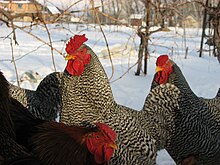|
Dominique chicken
The Dominique is an American breed of chicken, characterized by black-and-white barred plumage and a rose comb. It is considered to be the oldest American chicken breed,[8]: 121 and is thought to derive from birds brought to America by colonists from southern England. It was well known by about 1750, and by the mid-nineteenth century was widely distributed in the eastern United States.[9]: 429 [5]: 53 It is a dual-purpose breed, but is kept principally for its brown eggs.[9]: 429 It became an endangered breed in the twentieth century, but numbers have since recovered.[2] HistoryThe origins of the Dominique are unknown.[10] It is considered to be the oldest American chicken breed,[8]: 121 and is thought to derive from birds – probably similar to the modern Dorking or Sussex breeds – brought to America by colonists from southern England. Chickens with barred plumage, with either a single or a rose comb, were well known by about 1750, and by the mid-nineteenth century were widely distributed in the eastern United States.[5]: 53 [9]: 429 They were known by many names – among them Blue Spotted Hen, Dominic, Dominicker, Dominico, Old Grey Hen and Pilgrim Fowl – but were commonly known as Dominique. Some of the earliest books on poultry include these as a valuable American breed.[11]: 97 Some were exhibited at the first American poultry show, held in Boston in 1849.[9]: 429 In the 1860s the Plymouth Rock was created by cross-breeding Black Java with large single-combed Dominiques; it was first exhibited in 1869.[2] It was rather larger than the Dominique, but otherwise fairly similar. At a poultry show in New York in 1870, the organisers ruled that only rose-combed barred birds could be exhibited as Dominiques; those with single combs were to be entered as Plymouth Rocks.[2][9]: 429 In 1871 this ruling was confirmed in a Standard of Excellence for the Dominique.[9]: 429 In 1874 the Dominique was included in the first edition of the American Standard of Perfection of the new American Poultry Association;[2] the Dominique bantam was added in 1960.[4]: 6 Breed numbers declined during the twentieth century, and by the 1970s the Dominique was close to disappearing. A recovery initiative was launched, and from 1983 numbers began to rise again.[2] Until about 2003 its conservation status was listed as "critical" by the American Livestock Breeds Conservancy (now the Livestock Conservancy), with fewer than 500 breeding birds in North America.[12] In 2021 it was listed as "watch" by the Livestock Conservancy, and was reported to DAD-IS as "not at risk".[2][3] Characteristics  The Dominique is of medium size, mature birds usually weighing some 5–7 lb (2.3–3.2 kg). The only recognized plumage coloration is cuckoo, sometimes known as "hawk" coloration, a regular pattern of light and dark – but not black and white – barring.[2] The head is carried high, and has a rose-comb with a single backwards-pointing spike; the earlobes and wattles are red, and the beak yellow.[2] The legs and feet are also yellow.[13]: 7 The plumage is held fairly tight to the body; because of this and the rose comb, it has better resistance to frostbite than some other breeds.[2] UseThe Dominique is a dual-purpose breed, but is kept principally for its brown eggs,[9]: 429 of which hens lay about 200 per year, with an average weight of 58 g.[10]: 33 ReferencesWikimedia Commons has media related to Dominique chicken.
Further reading
|
||||||||||||||||||||||||||||||||
